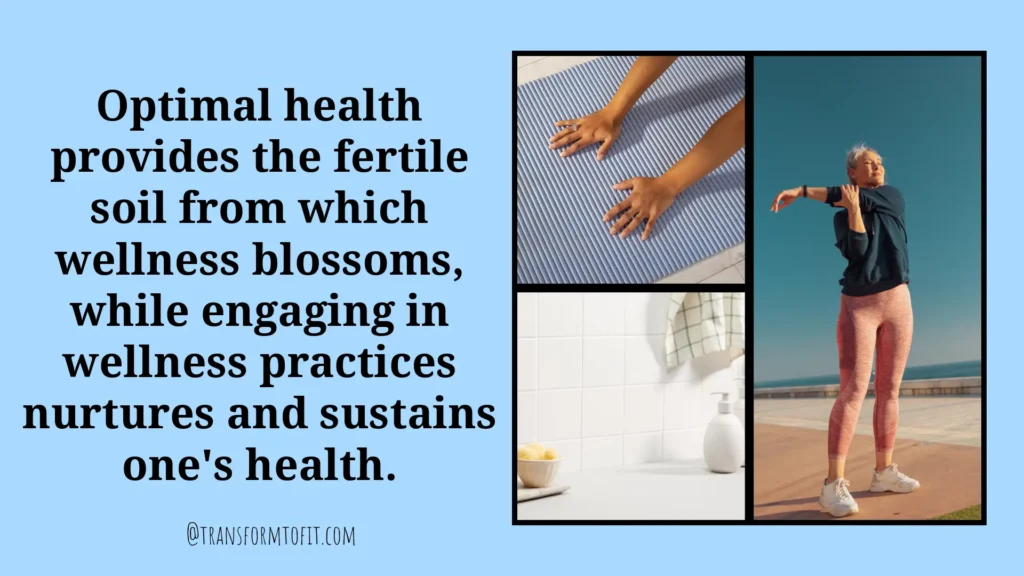In the labyrinth of life, the terms “health” and “wellness” often intersect, weaving a tapestry of well-being that encompasses various facets of our existence. (Health vs. Wellness) Yet, beneath the surface, distinct threads of meaning unravel, revealing the intricate differences between these two concepts. This exploration seeks to untangle these intricacies, offering insight into their individual significance and collective impact on our journey towards wholeness.
Unveiling the Essence of Health
At its core, health embodies the physiological state of the body, characterized by the absence of disease and the optimal functioning of bodily systems. The World Health Organization (WHO) extends this definition, encapsulating health as “a state of complete physical, mental, and social well-being and not merely the absence of disease or infirmity.” This comprehensive perspective illuminates health as a holistic state, encompassing not only bodily vitality but also mental and social equilibrium.
Navigating the Path of Wellness
Contrastingly, wellness emerges as the deliberate pursuit of actions, choices, and lifestyles that foster holistic well-being. It transcends mere physical health, encompassing a spectrum of dimensions, including emotional, environmental, financial, intellectual, occupational, social, and spiritual realms. Wellness embodies an ongoing journey of self-discovery and growth, inviting individuals to actively engage in practices that nurture their flourishing across diverse domains of existence.
Drawing Distinctions in Perspective (Health vs. Wellness)
The fundamental disparity between health and wellness lies in their orientation and scope. Health is often perceived as a state or objective to be attained, predominantly focusing on physical well-being and the absence of illness. In contrast, well-being embodies a dynamic process characterized by active participation in strategies that promote overall well-being and enhance the quality of life.

Health: The Foundational Pillar
Visualize health as the sturdy pillar upon which the edifice of well-being stands. It serves as the fundamental groundwork, providing stability and support for the pursuit of higher states of fulfillment and vitality. Without this sturdy foundation, the structure of wellness becomes precarious, lacking the necessary stability to thrive and flourish.
Wellness: The Artistry of Living
In contrast, well-being represents the artistry of living—a tapestry woven from the threads of conscious choices, purposeful actions, and mindful practices. It transcends the realm of mere physicality, encompassing the myriad dimensions of human experience. Wellness is the canvas upon which individuals paint their unique narratives, imbuing life with meaning, purpose, and vitality.
The Interwoven Tapestry of Well-Being
Although health and wellness manifest as distinct concepts, they are intricately interwoven, each influencing and enriching the other. Optimal health provides the fertile soil from which well-being blossoms, while engaging in wellness practices nurtures and sustains one’s health. Together, they form a symbiotic relationship, amplifying the benefits of each other and fostering a synergistic approach to holistic well-being.
Embracing a Holistic Paradigm
To cultivate a life of balance and fulfillment, it is imperative to embrace both health and wellness as integral components of well-being. This entails nurturing physical health through preventive care, healthy habits, and medical intervention when needed. Simultaneously, it involves nurturing holistic well-being by fostering emotional resilience, intellectual curiosity, social connections, and spiritual growth.
Conclusion: Embracing Wholeness
In the tapestry of life, health and wellness emerge as complementary threads, weaving together to create a vibrant mosaic of well-being. By discerning the subtle nuances between these concepts, we gain a deeper understanding of their interconnectedness and transformative potential. Embracing both health and wellness empowers us to navigate life’s complexities with grace and resilience, fostering a holistic approach to living that nurtures body, mind, and spirit alike.
FAQs: Understanding the Difference Between Health and Wellness
1. How do wellbeing and health differ from one another?
Health refers to the state of being free from illness or injury, encompassing physical, mental, and social well-being. It is often seen as a goal or as a state to maintain. Wellness, on the other hand, is the active pursuit of activities, choices, and lifestyles that lead to a holistic state of health. It involves a balanced approach to enhancing physical, mental, social, and spiritual well-being.
2. Can you be healthy but not well?
Yes, it is possible to be considered healthy in a medical sense—free from disease or chronic conditions—while still lacking in overall well-being. Wellness extends beyond physical health to include emotional stability, mental health, social connections, and spiritual fulfillment. If any of these aspects are neglected, a person might not feel well despite being healthy.
3. How does one achieve wellness?
Achieving well-being involves taking proactive steps toward a more balanced and fulfilling life. This can include regular physical activity, healthy eating, managing stress, fostering meaningful relationships, engaging in activities that promote mental and emotional health, and seeking personal and spiritual growth. It’s about making conscious decisions that benefit your overall well-being.
4. Why is it important to distinguish between health and well-being?
Understanding the distinction between health and well-being is crucial because it acknowledges that well-being is not solely the absence of disease. Recognizing this difference encourages individuals to actively engage in improving their quality of life across all aspects, not just focus on physical health. It promotes a more holistic approach to living a fulfilling and balanced life.
5. How do health and wellness influence each other?
Health and wellness are deeply interconnected. Good health can serve as a foundation for pursuing well-being, as it’s easier to engage in well-being activities when you’re not battling illness. Conversely, actively pursuing wellness through balanced living can prevent health issues, reduce stress, and improve one’s overall health. Engaging in wellness activities can lead to a healthier lifestyle, which, in turn, can prevent or mitigate health problems.
Latest Post
- The Power of Kickstand Squats for Enhancing Leg Strength and Muscular Development
- Lower Chest Cable Fly: Targeted Muscles, Execution Techniques, Advantages, and Effective Substitutes
- How to Do Weighted Pull-Ups: Mastering Strength Training Techniques
- 5 Benefits of Wall Sits: Only A Single Minute Every Day
- Sissy Squat Alternatives: Targeting Quadriceps Muscles Safely


Well information